Bass fishing is a popular and exciting sport that requires the right equipment and techniques to be successful. One critical aspect is choosing the best gear ratio for your fishing reel. The gear ratio determines how fast the line is retrieved, which impacts your ability to fish with specific lures and techniques effectively.
A proper gear ratio can make a significant difference in your fishing experience. For bass fishing, versatility is key, as different lures and baits require varying retrieval speeds. The most versatile gear ratios fall within the 6:1 or 7:1 range, since they allow you to fish with most lures and baits at various speeds However, specific techniques may call for higher or lower gear ratios.
Understanding gear ratios and their role in bass fishing is essential for tailoring your equipment to optimize your technique. Depending on your approach, your ideal reel may differ; this article will guide you in selecting the best gear ratio for your bass fishing needs.
| Technique | Best Gear Ratio | Explanation |
|---|---|---|
| Flipping and pitching | 7.1:1 – 8.1:1 | Used for precise, short-range presentations to fish-holding cover. Faster gear ratios allow for quick line retrieval and effective hooksets. |
| Topwater Lures | 5.4:1 – 6.4:1 | Ideal for walking baits, poppers, and other surface lures. Slower gear ratios provide better control and cadence for effective topwater presentations. |
| Crankbaits | 5.4:1 – 6.6:1 | Provides the right balance of speed and control for effectively suspending jerkbaits with erratic, stop-and-go retrieves. |
| Spinnerbaits | 6.4:1 – 7.3:1 | Works well for covering water quickly and efficiently with these moving baits. Allows for a faster retrieve without sacrificing control. |
| Jerkbaits | 6.4:1 – 7.3:1 | Provides the right balance of speed and control for effectively working suspending jerkbaits with erratic, stop-and-go retrieves. |
| Swimbaits | 5.4:1 – 6.4:1 | Slower gear ratios help maintain a steady, natural swimming action with larger swimbaits, while providing enough torque for solid hooksets. |
| Drop shot Rigs | 6.4:1 – 7.3:1 | Offers fast line retrieval for efficient vertical presentations and quick repositioning. Allows for quick hooksets and line management. |
| Carolina rigs | 6.4:1 – 7.3:1 | Allows for efficient coverage of large areas and quick line retrieval when working heavy cover, while still maintaining control. |
| Jigs | 6.4:1 – 7.3:1 | Provides enough speed to effectively work bottom-hugging lures, while still offering sufficient control for precise presentations. |
| Frog Lures | 7.1:1 – 8.1:1 | Faster gear ratios are ideal for working hollow-bodied frogs across the surface and quickly retrieving slack line for powerful hooksets. |
Table of Contents
Understanding Gear Ratio
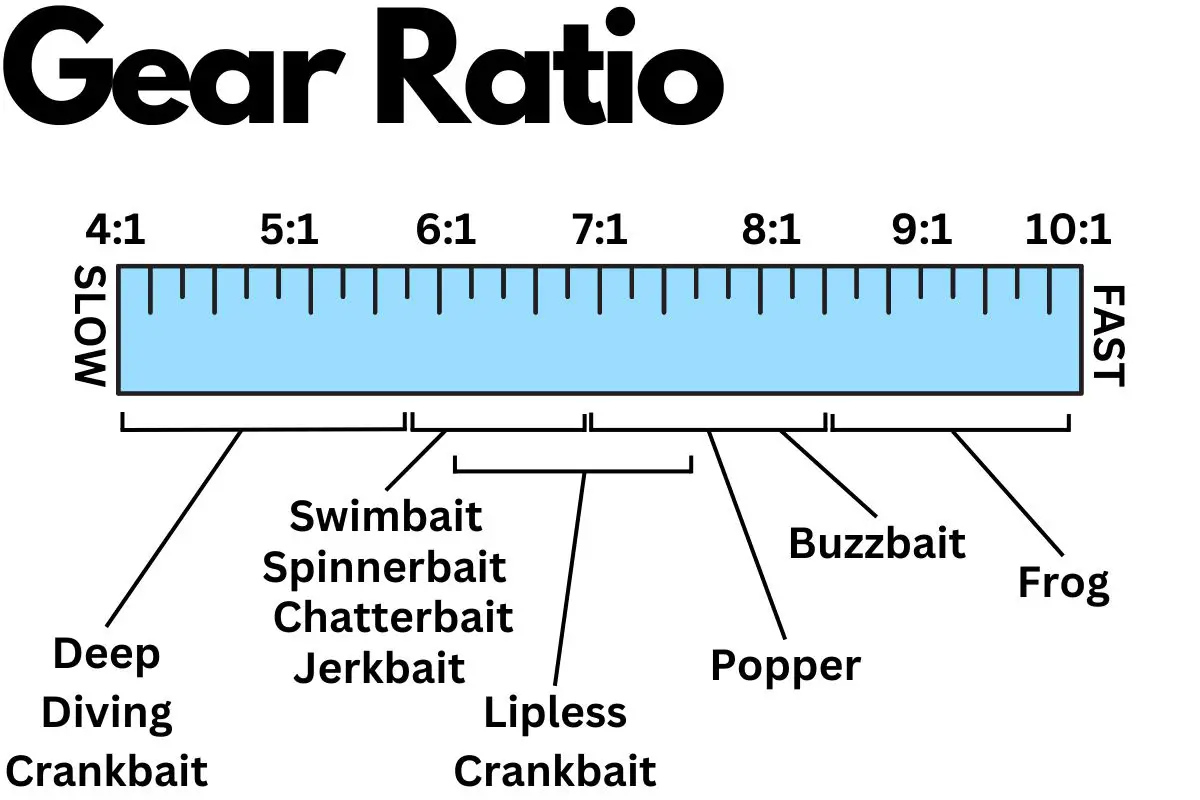
Gear Ratio Basics
A gear ratio refers to the speed at which a fishing reel retrieves line. It is represented by a number, such as 6:1, where the first number indicates the number of times the spool rotates with a single turn of the reel handle. In this case, the spool rotates six times for each handle turn.
There is a range of gear ratios available for bass fishing, including:
- Low gear ratio (5:1 or lower): Best for slow presentations and handling high-resistance lures.
- Medium gear ratio (6:1 to 7:1): The most versatile category, suitable for various lures and techniques.
- High gear ratio (8:1 or higher): Ideal for fast presentations and quickly retrieving slack line.
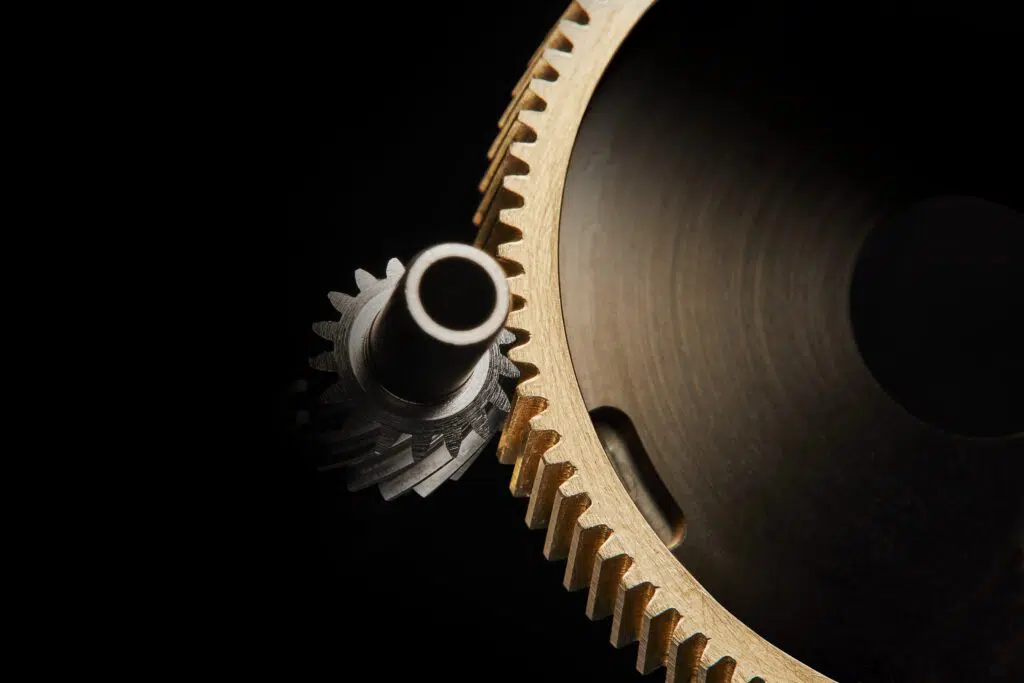
Importance of Gear Ratio in Bass Fishing
Selecting the right gear ratio is crucial for successful bass fishing, as it affects both lure presentation and angler efficiency. Here’s how different gear ratios play a role in various bass fishing techniques:
- Crankbaits – A faster gear ratio between 7:1 and 8:1 is recommended for crankbaits, as it allows for quick and efficient retrieval, covering more water and enticing more strikes.
- Topwater Lures – A medium gear ratio between 6:1 and 7:1 works well, providing an excellent balance between speed and control.
- Spinnerbaits – Medium to high gear ratios are suitable for most spinnerbait applications, allowing anglers to easily adapt retrieval speed based on their desired presentation.
- Jerkbaits – Medium gear ratio reels, such as 7:1, are preferred for jerkbait fishing, offering optimal control and versatility.
Understanding and selecting the appropriate gear ratio for given fishing situations can considerably improve an angler’s success on the water. It’s worth investing time to learn and experiment with various gear ratios to find the best combination for your preferred bass fishing techniques.
Selecting the Ideal Gear Ratio
When it comes to bass fishing, choosing the right gear ratio can greatly impact your performance on the water. This section will discuss the advantages and characteristics of low-speed, medium-speed, and high-speed gear ratios, helping you select the best one for various bass fishing techniques.
Low-Speed Gear Ratio
A low-speed gear ratio, typically around 5:1, is ideal for fishing with baits that generate a lot of resistance, such as deep diving crankbaits. The slower retrieve allows for more torque, making it easier to work these heavy baits and keep them deep where the fish are. Low-speed gear ratios are also suitable for:
- Deep water jigging
- Slow-rolling heavy spinnerbaits
- Working large swimbaits
Medium-Speed Gear Ratio
Medium-speed gear ratios, ranging from 6:1 to 7:1, are known for their versatility. They allow anglers to fish a wide range of lures and presentations effectively. A popular all-around ratio is the 6.2:1 which can be used for a variety of techniques such as:
- Shallow to medium depth crankbaits
- Jerkbaits
- Spinnerbaits
When using a medium gear ratio fishing reel, you can easily adapt your fishing technique as needed, making it a popular choice among bass anglers.
High-Speed Gear Ratio
High-speed gear ratios, 8:1 or higher, allow for faster retrieves and are ideal for quickly covering water or working lures closer to the surface. These gear ratios are particularly useful when working with:
- Topwater lures
- High-speed swimbaits
- Burning spinnerbaits
Using a high gear ratio fishing reel is advantageous for jerkbait fishing, with some anglers preferring a 10:1 ratio for quick and efficient retrieves.
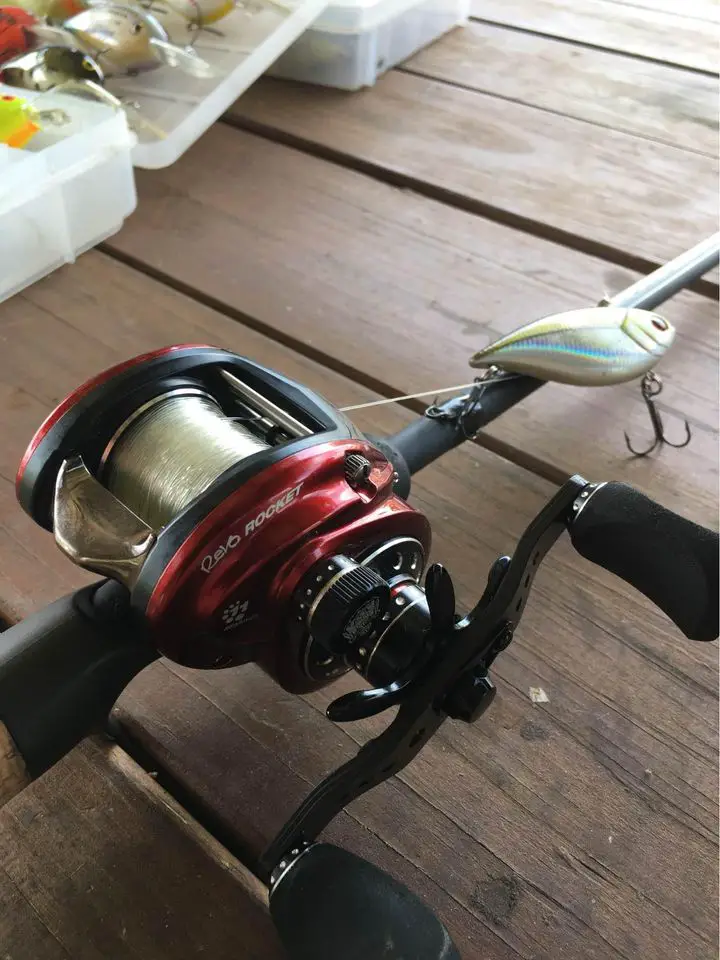
Choosing the ideal gear ratio for bass fishing depends on your specific technique and the presentation you wish to achieve. Experimenting with different gear ratios will enable you to find the right balance between retrieve speed and lure control, ultimately leading to more success on the water.
Fishing Techniques and Gear Ratios
The relationship between fishing techniques and gear ratios is critically important for anglers, especially when targeting bass. In this section, we’ll explore various techniques and their ideal gear ratios for maximum success, based on the type of lures or baits used.
Crankbaits
Crankbaits are diving lures that require a steady retrieve to work effectively. For deep-diving crankbaits and those that generate significant resistance, a slow reel in the range of 5:1 or lower is ideal. This slower reel allows for increased torque, thus reducing fatigue on the angler.
Jigs and Spinnerbaits
Regarding jigs and spinnerbaits, a medium gear ratio around 6:1 works best. This gear ratio suits various techniques, such as flipping, pitching, or casting. A medium gear ratio reel helps maintain the right balance of control and power when retrieving these lures through various vegetation types.
Topwater Lures
For topwater lures such as poppers, walking baits, or buzzbaits, a medium to fast gear ratio of 6:1 or higher is recommended. This higher ratio enables quicker line pickup, essential when fishing topwater baits with a lot of slack in the line.
Swimbaits and Frogs
Swimbaits and frogs are moving baits that are typically retrieved fairly quickly to entice bass into striking. A 7:1 gear ratio or higher works best for these lures, especially when fishing in heavy cover or through vegetation. High-speed reels ensure a solid hookset is possible, even when a bite occurs at a distance.
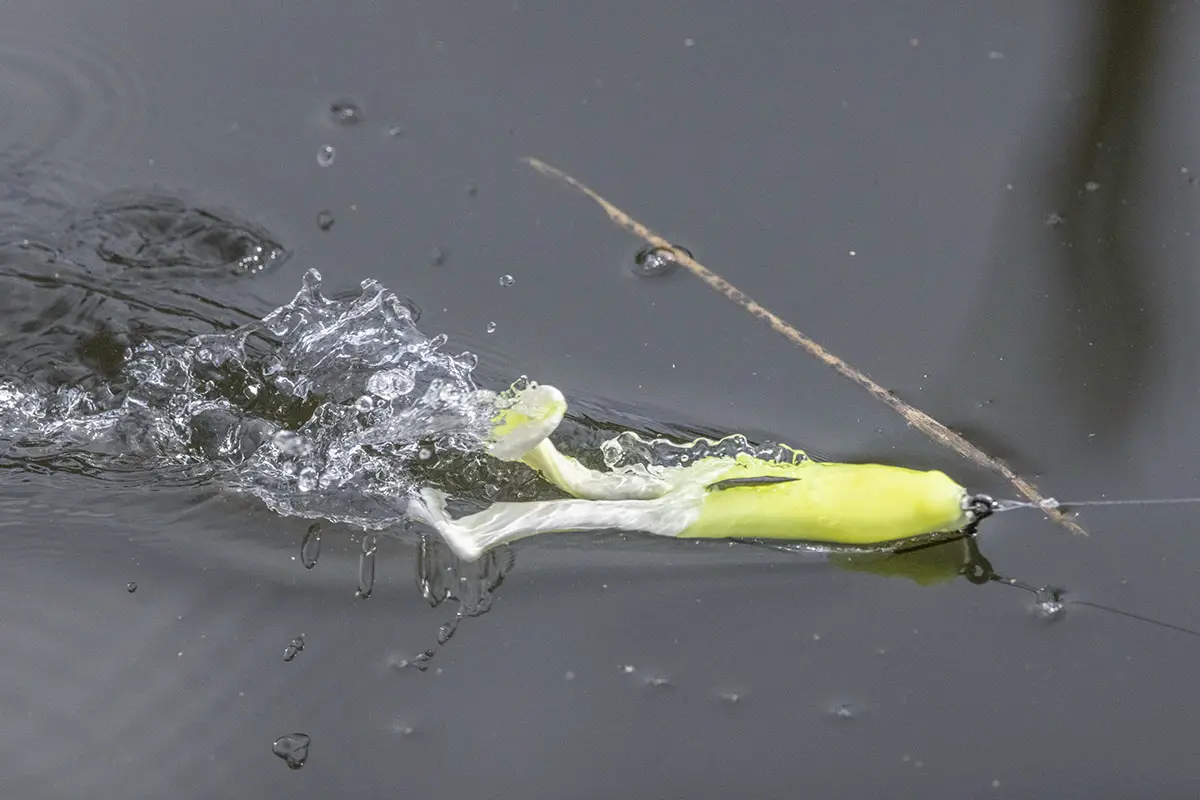
Carolina and Texas Rigs
Carolina and Texas rigs are bottom-bouncing techniques requiring a controlled retrieve to effectively present soft plastics or jigs. A medium gear ratio around 6:1 allows anglers to maintain contact with the bottom while still having the ability to react quickly to a bite.
Selecting the right gear ratio will depend on the type of lure or bait being used and the retrieve style. A slow reel works best for crankbaits, while jigs and spinnerbaits require a medium gear ratio. Topwater lures demand a fast gear ratio, and swimbaits or frogs benefit from high-speed reels. Finally, stick to a medium gear ratio for the best results when using Carolina or Texas rigs.
Reel Types and Gear Ratios
In this section, we will discuss the two main types of fishing reels used in bass fishing and the gear ratios associated with these different reels. Knowing the appropriate gear ratio for your fishing reel can help optimize your bait presentation and improve your catch rate.
Baitcasting Reels
Baitcasting reels are popular among bass anglers for their accuracy and ease of use when targeting specific cover or structure. These reels typically have lower gear ratios, ranging from 5:1 to 7:1. However, higher gear ratios up to 8.3:1 can be found on certain models as well.
- 5:1 or lower: Ideal for crankbaits and baits with higher resistance. They allow for a slower and steady retrieve.
- 6.1:1 – 6.4:1: Considered medium gear ratios, these reels are versatile, working well with jigs, plastic worms, and Carolina rigs. Classic baits like beetle-spins, plastic shad, and spoons are also suitable.
- 7:1 and higher: These high-speed reels excel at fast presentations, perfect for jerkbaits, topwater lures, and burning lipless crankbaits.
Spinning Reels
Spinning reels are versatile and user-friendly, making them popular among anglers of all skill levels. Spinning reels’ gear ratios are typically slower than baitcasting reels, which can help effectively control the presentation of several lures. Common gear ratios for spinning reels include:
- 5:1 or lower: Slow gear ratios work well with deep diving crankbaits and heavier baits that require a steady retrieve.
- 5.5:1 – 6.1:1: Medium gear ratios are best for general-purpose use and are suitable for a wide range of lures and techniques.
- 6.2:1 and higher: Faster gear ratios excel at quick presentations or retrieving slack line during a fight with a fish.
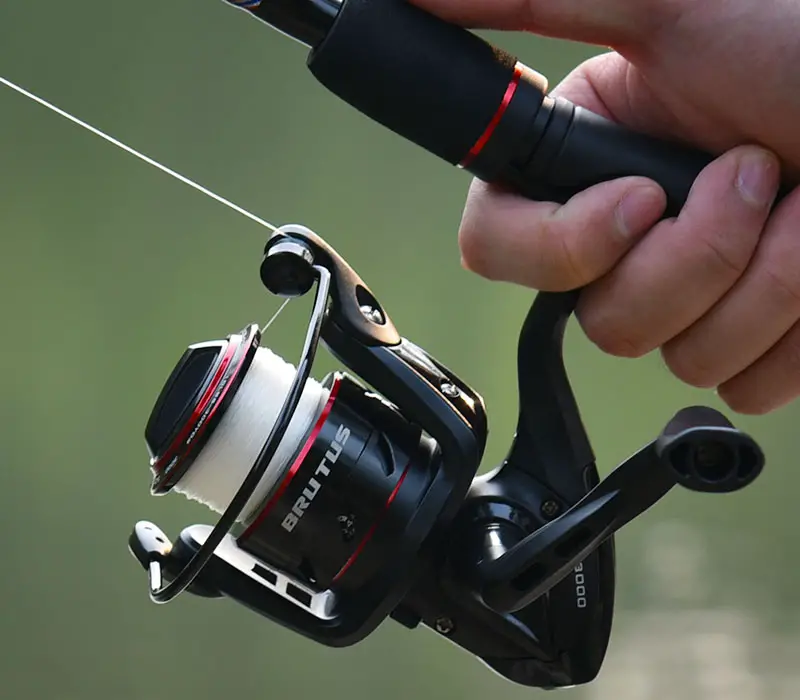
Choosing the right reel type and gear ratio can significantly impact your bass fishing success. By understanding the differences between baitcasting and spinning reels and their respective gear ratios, you can tailor your approach and optimize your chances of landing that big catch.
Additional Considerations
Efficiency and Inches per Turn
Efficiency plays a crucial role in bass fishing, as the right gear ratio allows anglers to cover water quickly and effectively. A medium gear ratio, like 6:1, balances speed and power, making it suitable for various fishing techniques. Pay attention to the Inches per Turn (IPT) of your reel, as it determines how much line is retrieved with each turn of the handle. A higher IPT helps anglers make long casts and efficiently cover open water using techniques like Carolina rigging or fishing with swim jigs.
Fishing in Open Water vs. Vegetation
Different gear ratios excel in various fishing environments:
- Open Water: Higher gear ratios, like 8.3:1, are suitable for open water situations that require quick line retrieval or long casts. This speed allows anglers to work surface lures effectively, such as plastics or other topwater baits.
- Vegetation: Lower gear ratios around 5:1 offer more torque for pulling fish out of heavy cover or vegetation. This ratio works well when worming or fishing in dense aquatic plants.
Rod Selection and Gear Ratio
Choosing the appropriate rod to match your reel’s gear ratio enhances fishing efficiency. For instance:
- Fast gear ratios work well with longer rods for maximum casting distance, especially when fishing with crankbaits, spinnerbaits, and surface lures in open water.
- Medium gear ratios pair well with versatile rod lengths and powers for various fishing applications, including plastics, swim jigs, and worms.
- Slow gear ratios suit shorter rods with heavier power for fishing in heavy vegetation, providing the necessary torque and control to handle the cover effectively.
Remember to experiment with gear ratios, rod selections, and fishing techniques to determine what works best for you and the specific bass fishing conditions.
Conclusion
Choosing the right gear ratio for bass fishing is crucial, especially when trying different techniques. A medium gear ratio around for beginners is considered versatile and suitable for most situations.
When fishing with slow-rolling spinnerbaits or buzz baits, a slower gear ratio (5:1 or lower) might be more appropriate as it allows for more control and less fatigue. On the other hand, shallow diving crankbaits and topwater lures benefit from a higher gear ratio (7:1 or higher) for faster retrievals and keeping the bait on the surface.
While navigating through lily pads or wood, a medium gear ratio is preferable as it provides a good balance between speed and control.
Experiment with different gear ratios and techniques to find the best combination for your specific bass fishing environment. Consider the type of baits, target area, and water conditions when selecting the perfect gear ratio.
